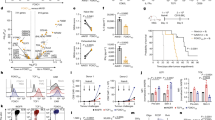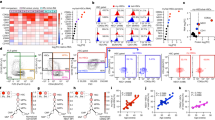Abstract
The ex vivo priming and expansion of human cytotoxic T lymphocytes (CTLs) has potential for use in immunotherapy applications for cancer and infectious diseases. To overcome the difficulty in obtaining sufficient numbers of CTLs, we have developed artificial antigen-presenting cells (aAPCs) expressing ligands for the T-cell receptor (TCR) and the CD28 and 4-1BB co-stimulatory surface molecules. These aAPCs reproducibly activate and rapidly expand polyclonal or antigen-specific CD8+ T cells. The starting repertoire of CD8+ T cells was preserved during culture. Furthermore, apoptosis of cultured CD8+ T cells was diminished by this approach. This approach may have important therapeutic implications for adoptive immunotherapy.
This is a preview of subscription content, access via your institution
Access options
Subscribe to this journal
Receive 12 print issues and online access
$209.00 per year
only $17.42 per issue
Buy this article
- Purchase on Springer Link
- Instant access to full article PDF
Prices may be subject to local taxes which are calculated during checkout






Similar content being viewed by others
References
Melief, C.J. & Kast, W.M. T-cell immunotherapy of tumors by adoptive transfer of cytotoxic T lymphocytes and by vaccination with minimal essential epitopes. Immunol. Rev. 145, 167–177 (1995).
Riddell, S.R. & Greenberg, P.D. Principles for adoptive T cell therapy of human viral diseases. Annu. Rev. Immunol. 13, 545–586 (1995).
Riddell, S.R. et al. Restoration of viral immunity in immunodeficient humans by the adoptive transfer of T cell clones. Science 257, 238–241 (1992).
Yee, C. et al. Melanocyte destruction after antigen-specific immunotherapy of melanoma. Direct evidence of T cell-mediated vitiligo. J. Exp. Med. 192, 1637–1644 (2000).
Brodie, S.J. et al. In vivo migration and function of transferred HIV-1-specific cytotoxic T cells. Nat. Med. 5, 34–41 (1999).
Riddell, S.R. et al. Phase I study of cellular adoptive immunotherapy using genetically modified CD8+ HIV-specific T cells for HIV seropositive patients undergoing allogeneic bone marrow transplant. The Fred Hutchinson Cancer Research Center and the University of Washington School of Medicine, Department of Medicine, Division of Oncology. Hum. Gene Ther. 3, 319–338 (1992).
Riddell, S.R. & Greenberg, P.D. The use of anti-CD3 and anti-CD28 monoclonal antibodies to clone and expand human antigen-specific T cells. J. Immunol. Methods 128, 189–201 (1990).
Heslop, H.E. et al. Long-term restoration of immunity against Epstein–Barr virus infection by adoptive transfer of gene-modified virus-specific T lymphocytes. Nat. Med. 2, 551–555 (1996).
Levine, B.L. et al. Effects of CD28 costimulation on long-term proliferation of CD4+ T cells in the absence of exogenous feeder cells. J. Immunol. 159, 5921–5930 (1997).
Deeths, M.J., Kedl, R.M. & Mescher, M.F. CD8+ T cells become nonresponsive (anergic) following activation in the presence of costimulation. J. Immunol. 163, 102–110 (1999).
Laux, I. et al. Response differences between human CD4(+) and CD8(+) T-cells during CD28 costimulation: implications for immune cell-based therapies and studies related to the expansion of double-positive T-cells during aging. Clin. Immunol. 96, 187–197 (2000).
Deeths, M.J. & Mescher, M.F. B7-1-dependent co-stimulation results in qualitatively and quantitatively different responses by CD4+ and CD8+ T cells. Eur. J. Immunol. 27, 598–608 (1997).
Pollok, K.E. et al. Inducible T cell antigen 4-1BB. Analysis of expression and function. J. Immunol. 150, 771–781 (1993).
Goodwin, R.G. et al. Molecular cloning of a ligand for the inducible T cell gene 4-1BB: a member of an emerging family of cytokines with homology to tumor necrosis factor. Eur. J. Immunol. 23, 2631–2641 (1993).
Hurtado, J.C., Kim, Y.J. & Kwon, B.S. Signals through 4-1BB are costimulatory to previously activated splenic T cells and inhibit activation-induced cell death. J. Immunol. 158, 2600–2609 (1997).
Hurtado, J.C., Kim, S.H., Pollok, K.E., Lee, Z.H. & Kwon, B.S. Potential role of 4-1BB in T cell activation. Comparison with the costimulatory molecule CD28. J. Immunol. 155, 3360–3367 (1995).
Saoulli, K. et al. CD28-independent, TRAF2-dependent costimulation of resting T cells by 4-1BB ligand. J. Exp. Med. 187, 1849–1862 (1998).
Shuford, W.W. et al. 4-1BB costimulatory signals preferentially induce CD8+ T cell proliferation and lead to the amplification in vivo of cytotoxic T cell responses. J. Exp. Med. 186, 47–55 (1997).
Takahashi, C., Mittler, R.S. & Vella, A.T. Cutting edge: 4-1BB is a bona fide CD8 T cell survival signal. J. Immunol. 162, 5037–5040 (1999).
Tan, J.T. et al. 4-1BB costimulation is required for protective anti-viral immunity after peptide vaccination. J. Immunol. 164, 2320–2325 (2000).
Melero, I. et al. Monoclonal antibodies against the 4-1BB T-cell activation molecule eradicate established tumors. Nat. Med. 3, 682–685 (1997).
Melero, I. et al. Amplification of tumor immunity by gene transfer of the co-stimulatory 4-1BB ligand: synergy with the CD28 co-stimulatory pathway. Eur. J. Immunol. 28, 1116–1121 (1998).
DeBenedette, M.A., Shahinian, A., Mak, T.W. & Watts, T.H. Costimulation of CD28− T lymphocytes by 4–1BB ligand. J. Immunol. 158, 551–559 (1997).
Guinn, B.A., DeBenedette, M.A., Watts, T.H. & Berinstein, N.L. 4-1BBL cooperates with B7-1 and B7-2 in converting a B cell lymphoma cell line into a long-lasting antitumor vaccine. J. Immunol. 162, 5003–5010 (1999).
Latouche, J.B. & Sadelain, M. Induction of human cytotoxic T lymphocytes by artificial antigen-presenting cells. Nat. Biotechnol. 18, 405–409 (2000).
Prakken, B. et al. Artificial antigen-presenting cells as a tool to exploit the immune 'synapse'. Nat. Med. 6, 1406–1410 (2000).
Almand, B. et al. Clinical significance of defective dendritic cell differentiation in cancer. Clin. Cancer Res. 6, 1755–1766 (2000).
Rosenberg, S.A. et al. Gene transfer into humans—immunotherapy of patients with advanced melanoma, using tumor-infiltrating lymphocytes modified by retroviral gene transduction. N. Engl. J. Med. 323, 570–578 (1990).
Dudley, M.E. et al. Adoptive transfer of cloned melanoma-reactive T lymphocytes for the treatment of patients with metastatic melanoma. J. Immunother. 24, 363–373 (2001).
Yee, C., Riddell, S.R. & Greenberg, P.D. In vivo tracking of tumor-specific T cells. Curr. Opin. Immunol. 13, 141–146 (2001).
Rooney, C.M. et al. Infusion of cytotoxic T cells for the prevention and treatment of Epstein–Barr virus-induced lymphoma in allogeneic transplant recipients. Blood 92, 1549–1555 (1998).
Lord, J.D., McIntosh, B.C., Greenberg, P.D. & Nelson, B.H. The IL-2 receptor promotes proliferation, bcl-2 and bcl-x induction, but not cell viability through the adapter molecule Shc. J. Immunol. 161, 4627–4633 (1998).
Dahl, A.M. et al. Expression of bcl-X(L) restores cell survival, but not proliferation of effector differentiation, in CD28-deficient T lymphocytes. J. Exp. Med. 191, 2031–2038 (2000).
Dunbar, P.R. et al. Direct isolation, phenotyping and cloning of low-frequency antigen-specific cytotoxic T lymphocytes from peripheral blood. Curr. Biol. 8, 413–416 (1998).
Yee, C., Savage, P.A., Lee, P.P., Davis, M.M. & Greenberg, P.D. Isolation of high avidity melanoma-reactive CTL from heterogeneous populations using peptide–MHC tetramers. J. Immunol. 162, 2227–2234 (1999).
Curtsinger, J.M., Lins, D.C. & Mescher, M.F. CD8+ memory T cells (CD44high, Ly-6C+) are more sensitive than naive cells to (CD44low, Ly-6C−) to TCR/CD8 signaling in response to antigen. J. Immunol. 160, 3236–3243 (1998).
Sagerstrom, C.G., Kerr, E.M., Allison, J.P. & Davis, M.M. Activation and differentiation requirements of primary T cells in vitro. Proc. Natl. Acad. Sci. USA 90, 8987–8991 (1993).
Wang, B., Maile, R., Greenwood, R., Collins, E.J. & Frelinger, J.A. Naive CD8+ T cells do not require costimulation for proliferation and differentiation into cytotoxic effector cells. J. Immunol. 164, 1216–1222 (2000).
Voltz, R. et al. A serologic marker of paraneoplastic limbic and brain-stem encephalitis in patients with testicular cancer. N. Engl. J. Med. 340, 1788–1795 (1999).
Tan, E.M. Autoantibodies as reporters identifying aberrant cellular mechanisms in tumorigenesis. J. Clin. Invest 108, 1411–1415 (2001).
June, C.H., Ledbetter, J.A., Gillespie, M.M., Lindsten, T. & Thompson, C.B. T-cell proliferation involving the CD28 pathway is associated with cyclosporine-resistant interleukin 2 gene expression. Mol. Cell Biol. 7, 4472–4481 (1987).
Riley, J.L. et al. ICOS costimulation requires IL-2 and can be prevented by CTLA-4 engagement. J. Immunol. 166, 4943–4948 (2001).
Claret, E.J. et al. Characterization of T cell repertoire in patients with graft-versus-leukemia after donor lymphocyte infusion. J. Clin. Invest 100, 855–866 (1997).
Acknowledgements
We thank William DeMuth for flow sorting, Patricia Rivers and Alanna Toll for technical help, and Coral Hass for administrative excellence. MHC tetramers were supplied by the NIAID Tetramer Facility and the NIH AIDS Research and Reference Reagent Program. Peptide synthesis was provided by the Protein Chemistry Laboratory of the Medical School of the University of Pennsylvania supported by core grants of the Diabetes and Cancer Centers (DK-19525 and CA-16520). M.V.M. was supported in part by training grant DK07748 from the NIH; A.K.T. was supported in part by the Dr. Mildred-Scheel-Stiftung Deutsche Krebschilfe Foundation Grant.
Author information
Authors and Affiliations
Corresponding author
Ethics declarations
Competing interests
A patent application on the work has been submitted on behalf of the University of Pennsylvania.
Rights and permissions
About this article
Cite this article
Maus, M., Thomas, A., Leonard, D. et al. Ex vivo expansion of polyclonal and antigen-specific cytotoxic T lymphocytes by artificial APCs expressing ligands for the T-cell receptor, CD28 and 4-1BB. Nat Biotechnol 20, 143–148 (2002). https://doi.org/10.1038/nbt0202-143
Received:
Accepted:
Issue Date:
DOI: https://doi.org/10.1038/nbt0202-143
This article is cited by
-
Succinylation-associated lncRNA signature to predict the prognosis of colon cancer based on integrative bioinformatics analysis
Scientific Reports (2023)
-
Affinity-matured DLL4 ligands as broad-spectrum modulators of Notch signaling
Nature Chemical Biology (2023)
-
Optimizing the manufacturing and antitumour response of CAR T therapy
Nature Reviews Bioengineering (2023)
-
Engineered soluble, trimerized 4-1BBL variants as potent immunomodulatory agents
Cancer Immunology, Immunotherapy (2023)
-
Nanoparticle-based modulation of CD4+ T cell effector and helper functions enhances adoptive immunotherapy
Nature Communications (2022)



